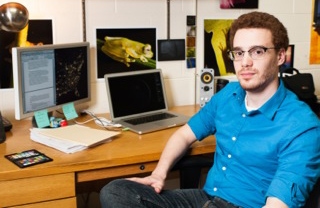Cochranella midas in vivo - Josh Shagram
© Josh Shagram
2012 BioImages Best of Show
This image of a species of "glass frog" perched on a branch was taken by Josh Shagram in the Ecuadorian Amazon Rainforest in South America, where he traveled with field biologists from the Biodiversity Group (biodiversitygroup.org).
"Every night when the temperature was cooler and the wildlife came out of hiding, we strapped on LED headlamps and camera gear and were taken for long hikes. The abundance of creatures in the rainforest is astounding, but it takes a careful eye to spot a frog or spider at night--the headlamps were essential to spotting subjects and providing light to focus and compose shots."
"This photo was taken with my Canon 20D, 100mm macro and MR-14EX Macro Ring Flash while the frog was perched on a branch with the ring flash positioned off to the right. These frogs are, as the name implies, somewhat transparent, often to the point of being able to see its internal organs and its heartbeat. I thought that side lighting would begin to transilluminate the frog to make it glow. It's hard to get a sense of scale, but this particular frog was only about an inch and a half in length."
"The use of flash and the fact that it was after sunset allowed for the stark, black falloff of the background and ultimate control of the illumination on the subject. While the ring flash mounted to the lens can be great in some circumstances, I spent a lot of my time positioning the ring flash off-axis thanks to the extendable coiled cord."
Read more about this photographer
 Josh Shagram studied Biomedical Photographic Communications at Rochester Institute of Technology from 2006-2010. He currently works at RIT as a lecturer in the Biomedical Photo program.
Josh Shagram studied Biomedical Photographic Communications at Rochester Institute of Technology from 2006-2010. He currently works at RIT as a lecturer in the Biomedical Photo program.
"I'm not sure that I have a specialty yet, but my area of interest and comfort is shooting macro with natural light and a compositional emphasis on design and form," he said. "Even the smallest, simplest structures and occurrences in nature can be shown to have beautiful lines, shapes and visual flow."
Below, Shagram shares insight into his field of macro photography and advice for other photographers interested in entering this field.
Describe your typical workday.
My typical day consists of talking to students about techniques in macro and micrography and working with them in our shooting lab to tackle the unique challenges of scientific photography. I will typically go off into the corner to do some shooting myself to try out ideas I'm considering developing into assignments for students--I spend a lot of time thinking about the role of software and equipment in providing the tools for making exciting images. My typical workday has me lecturing, discussing, and tinkering with photography in some form more or less non-stop!
What is the most used computer-editing tool in your workflow?
I cannot live without Adobe Lightroom 4. Of course I did manage not too long ago before it existed, but I'm glad I will never have to go back to the days before Lightroom. It's fantastic for organizing, keywording, 90% of the editing I need to do, and batch exporting. I've also recently become fanatical about tagging photos with GPS coordinates using my smartphone to track location data when I'm out shooting. It's fascinating and fun to be able to sort through your archive of photos by subject but now also location! Right now it's mostly fun for me to have that additional information embedded in my photos, but I've begun to think about the useful applications of GPS data in photography – especially in nature conservation and field research.
What elements are important to you when you judge or critique your work or the work of other professional photographers?
When I look at photographic work I'm particularly keen on craft and aesthetics. I don't necessarily need to understand the content – especially if it's highly scientific or technical in nature – because I believe that a skilled photographer can communicate its visual merits successfully. I love color and simplicity, so use of those in composition and visual emphasis are high on my list. I'm tough on my own work and am very critical about sharpness!
Do you have any advice for photographers interested in a career in biomedical/life sciences photography?
I don't have much in the way of advice, as I'm still just starting out my own career! It's important to find something you like to shoot that's separate from the work you do professionally. Sometimes it really helps you remember why photography is so enjoyable when you can shut down the part of your brain worried about getting it perfect, or catching the right moment. The act of shooting with no other preconceived notions or expectations is something I need to recharge my passion for photography.
